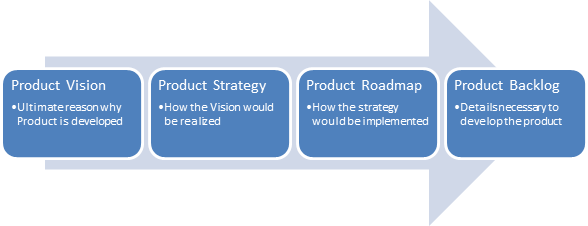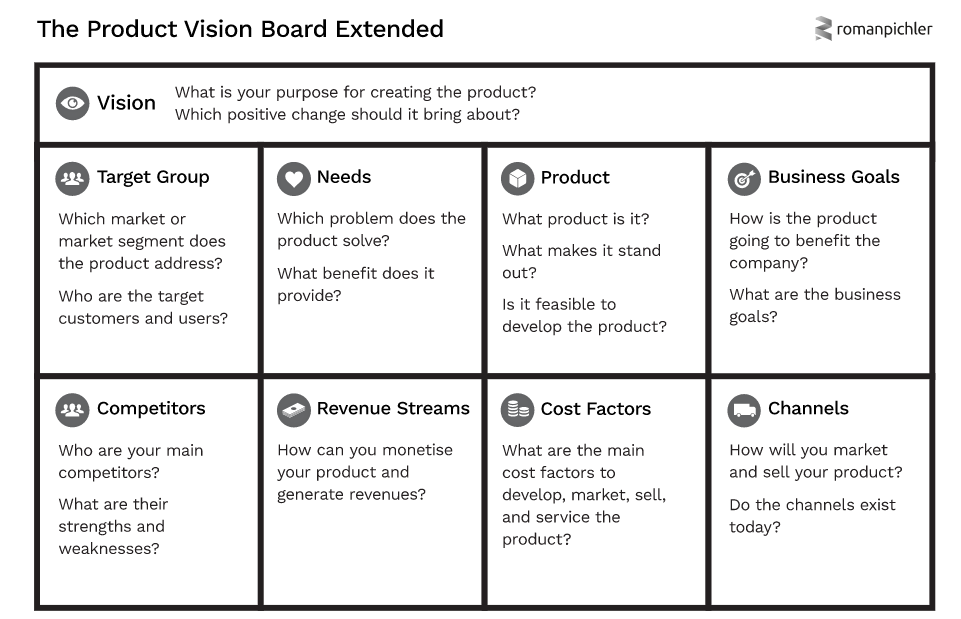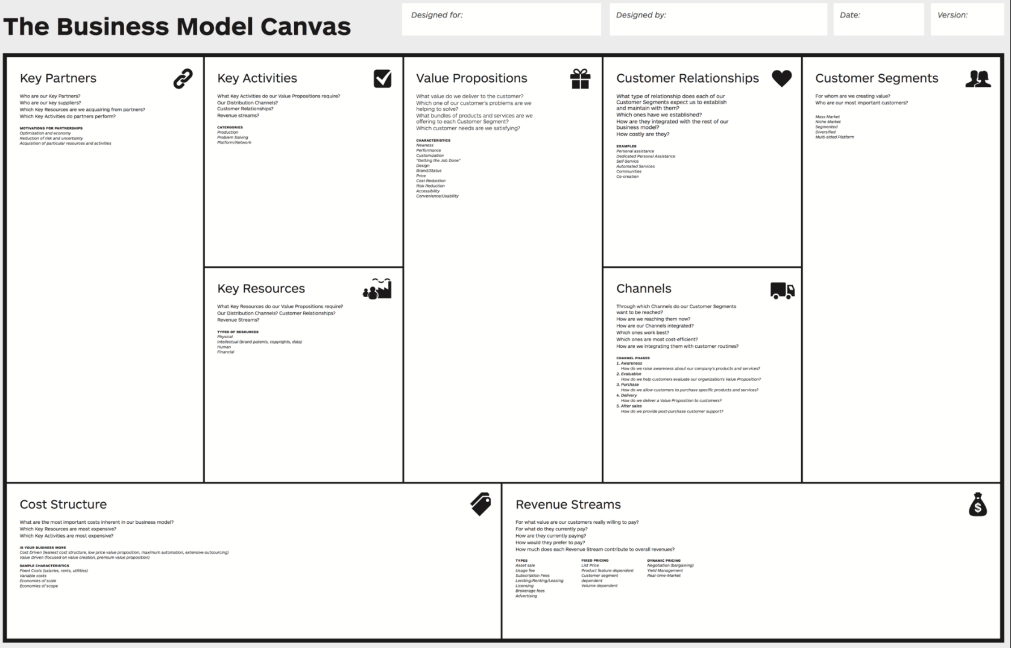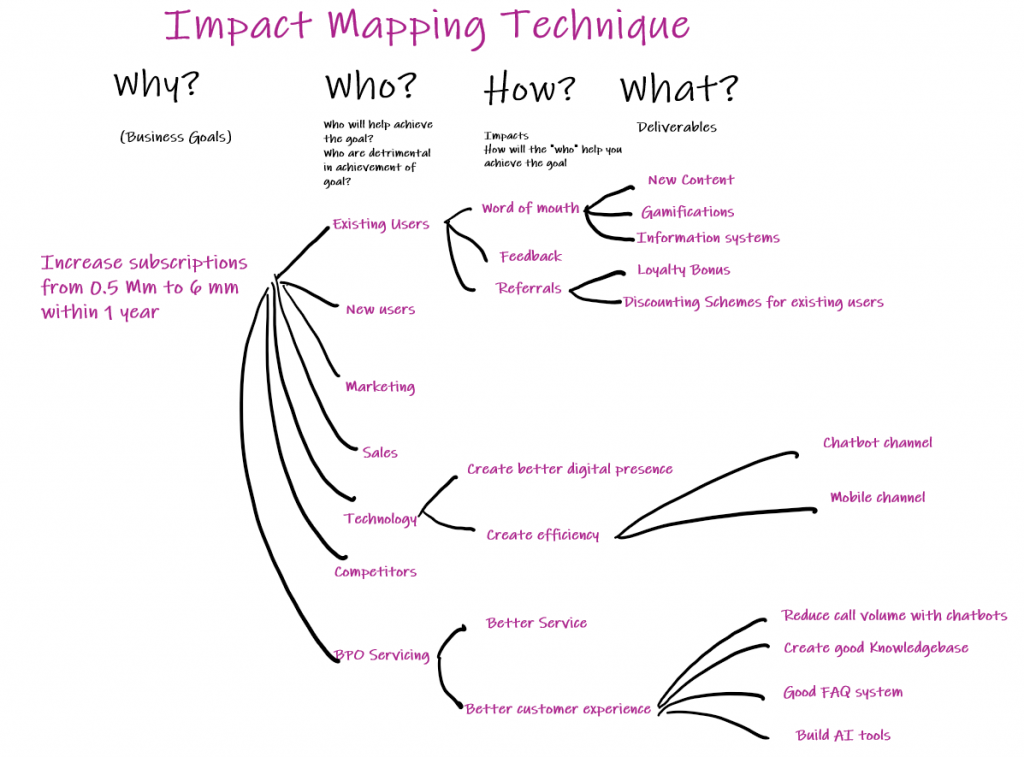Product Strategy and Product Roadmap
- Product Strategy describes how the long-term goal is attained. It includes the product’s value proposition, market, key features and business goals.
- Product Roadmap shows how the product strategy is put into action by stating specific releases with dates, goals and features. In short, Product Roadmap is a timeline view of the Product Strategy.
- Broadly, the following diagram depicts how Product Vision, Product Strategy, Product Roadmap and Product Backlog relate to each other

Strategy Templates
Documenting the Strategy in templates is the easiest part of creating the strategy. There are literally hundreds of templates in the industry. One can use anything. Broadly all the strategy templates describe similar fields with some variations.
Roman Pichler’s Extended Vision Board Template
Ref: Romanpichler.com and his book Strategy

Business Model Canvas
Reference : nine business model building blocks, Osterwalder, Pigneur & al. 2010

Impact Mapping Technique for writing Product Strategy
Impact mapping is a lightweight, collaborative planning technique. This technique help delivery teams and stakeholders visualize product strategy, explain how deliverables connect to user needs, and communicate how user outcomes relate to higher level organizational goals.

Steps to creating Impact Map
Step 1 : Define the Goal
When creating the map you should start with the goal that seems the most important, go on with the actors that seems the best to help you reach the goal, go with their main needs and behaviours, and the most focused and simple solutions for the needs and behaviours. When these are done, you can continue to explore the rest of the map in a similar fashion. You never build the whole map from the beginning, that is wasteful. The objective is to find the shortest route on the map to the most effective and efficient solution.
Impact mapping is done from the top down. It is very common that one has an idea for a solution and no one has actually considered the problem or how to know when a possible problem is solved, before building that solution. To make sure we do not waste any time or effort, we start with a problem statement in the form of a goal. The question we should ask ourselves is “Why are we doing this?”.
The main reason for forming the answer to that question as a goal is to be able to reevaluate the map we’ll be building as soon as we get new information, such as a change in the market, an invalidated assumption about our users or a possible new solution. Another reason is to focus the actual realisation of the solution on what needs to be done and remove all other waste, for instance feature ideas that pop up during development because they are easy to do, would look cool or someone saw the competitors have the feature. The goal will help you decide if you should actually build those features or not.
The goal should be a SMART one. This stands for Specific, Measurable, Attainable, Relevant and Time-based. The goal should be specific as in “Higher revenue through more guests staying in our hotel”, measurable as in “20% more guests”, attainable as in asserting that we have room for 20% more guests, relevant as in asserting that 20% more guests will actually give a significantly higher revenue (taking costs and other considerations into consideration), and time-based as in it is possible within a given time frame such as “20% per month” and we want to reach that number “before March 2017”. The goal could then be abbreviated to a more easy to read format:
Nothing on the map is considered truth until we have validated it with actors and ourselves (such as actually having a goal that is supported by a well founded business case).
Step 2 : Identify the Actors
The goal won’t be reached without someone’s help, and this someone is called an actor. Actors can be customers, users, your staff, other organizations, authorities and others. To map the actors, we ask ourselves questions such as
- Who can produce the effect?.
- Who are the users?,
- Who will be impacted by it?,
- Who will obstruct it?.
Important actors are those who directly influence the success of a product. These can be categorized as primary, secondary and off-stage actors. Primary actors are those whose goals and needs are fulfilled by the product, they get value from it. Secondary actors are those whose lives are impacted by the product. Off-stage actors are those who impact the product.
Step 3 – Identify the Impacts
The impact level of the map sets the actors in the perspective of the business goal by specifying the impacts we want to create, by thinking about how the actors can help us reach the goal. For some actors, mostly the users/customers, it is about what needs and motivations we need to address. And for others, like our sales staff or similar, it is about how we can change their behavior. It is also a good idea to map out how they can obstruct us or prevent us from succeeding.
The key is to understand the needs and behaviors of our actors by thinking about what job they want to do, in comparison to what they feel or think. This will help us coming up with different and possibly better ideas for solutions. Since these jobs would be directly connected to the solution (and we would also try to validate that it will help us reach the desired goal, of course), they can be used strategically and tactically for prioritization and understanding throughout the project.
Step 4 – Identify the Deliverables
The last step is to identify the deliverables. The deliverables will be followed by solutions which can be identified through the user story mapping techniques which will follow this technique.